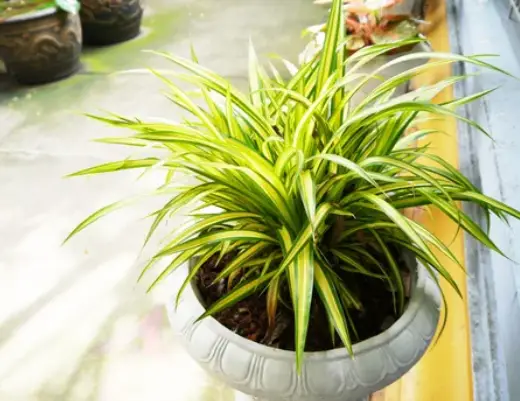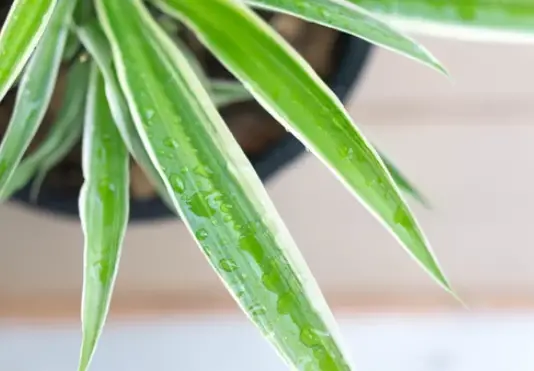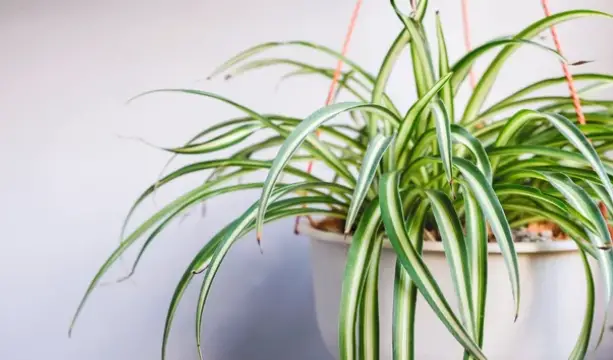Spider plants are one of the most popular houseplants around the world, thanks to their easy care and beautiful appearance.
But as with any plant, proper watering is critical to keep them thriving.
In this blog post, we’ll answer the question, “Do spider plants need a lot of water?” and provide tips on how to water them properly.
Understanding the Watering Needs of Spider Plants

Spider plants are native to the tropics, where they grow in a range of environments from wet rainforests to dry deserts.
As a result, they are adaptable and can tolerate a wide range of moisture conditions. However, like all plants, they have their preferences.
The key to watering spider plants is to find the balance between keeping the soil moist enough for healthy growth and preventing overwatering, which can lead to root rot and other problems.
In general, spider plants prefer evenly moist soil, but they don’t like to sit in water for extended periods. Therefore, it’s important to ensure that the soil has good drainage and to avoid letting the plant stand in water.
Factors Affecting Spider Plant Watering Requirements
Several factors can influence the watering needs of spider plants, including:
- Humidity: Spider plants like high humidity, but excessive moisture in the air can affect their watering needs. In dry environments, they may need more frequent watering, while in humid environments, they may require less.
- Temperature: Spider plants prefer temperatures between 60°F to 75°F (15.5°C to 24°C), and their watering needs will vary based on the temperature. In warmer environments, they may need more water, while in cooler environments, they may require less.
- Pot size: The size of the pot also affects the watering needs of spider plants. Smaller pots dry out more quickly and may require more frequent watering, while larger pots hold more moisture and may need less.
- Soil type: The type of soil used for spider plants can also affect their watering needs. Well-draining soil that retains moisture but allows excess water to drain away is ideal for these plants.
Do Spider Plants Need a Lot of Water?

Spider plants do not need a lot of water, but they do require consistent moisture to thrive. The key is to find the right balance between keeping the soil moist and avoiding overwatering. It’s important to check the soil moisture regularly and water only when the top inch of soil feels dry to the touch.
During the summer months or in warmer environments, spider plants may need more frequent watering, while in the winter months or in cooler environments, they may require less water.
Ultimately, the watering needs of spider plants can vary depending on factors such as humidity, temperature, pot size, and soil type, so it’s important to pay attention to these factors and adjust your watering accordingly.
How to Water Spider Plants
The best way to water spider plants is to check the soil moisture regularly and water only when the top inch of the soil feels dry to the touch.
When watering, pour water slowly and evenly into the soil until it begins to drain out the bottom of the pot. This ensures that the soil is thoroughly moistened without becoming waterlogged.
During the summer months or in warmer environments, spider plants may need more frequent watering. Conversely, in the winter months or in cooler environments, they may require less water.
It’s also important to avoid getting water on the foliage, as this can lead to fungal and bacterial diseases. Instead, water is at the base of the plant and allows the soil to absorb the moisture.
How Do I Know If My Spider Plant Needs Water?
It’s important to keep the soil of your spider plant consistently moist, but not waterlogged. Overwatering can lead to root rot, while underwatering can cause the leaves to wilt and turn brown.
To know if your spider plant needs water, you can check the soil moisture by sticking your finger about an inch deep into the soil.
If the soil feels dry to the touch, it’s time to water your plant. However, if the soil still feels moist, it’s best to hold off on watering until it dries out a bit more.
Another way to check if your spider plant needs water is to observe the leaves.
If the leaves are drooping and starting to turn brown or yellow, this may be a sign that the plant is not getting enough water.
However, if the leaves are turning yellow and becoming mushy, this may be a sign of overwatering.
It’s important to note that the watering needs of your spider plant can vary depending on factors such as the size of the pot, the type of soil, and the environment it’s in.
During the summer months or in warmer environments, your spider plant may require more frequent watering, while in the winter months or in cooler environments, it may require less water.
However,, it’s better to err on the side of underwatering rather than overwatering, as spider plants are more tolerant of dry soil than waterlogged soil.
With a bit of observation and attention to the soil moisture, you can ensure that your spider plant receives the right amount of water and thrives in its new home.
Do Spider Plants Need Much Sunlight?

Spider plants can tolerate a wide range of lighting conditions, but they do need some sunlight to thrive. While they can tolerate low light and indirect sunlight, they will grow best in bright, indirect light.
Direct sunlight can be too harsh for spider plants and may cause their leaves to scorch, so it’s best to avoid placing them in direct sunlight. Instead, place them near a window that is shaded by a sheer curtain or in a well-lit room that receives plenty of indirect sunlight.
In low-light conditions, spider plants will grow more slowly, and their leaves may be slightly smaller, but they will still thrive.
However, if they are kept in too low light for too long, they may become leggy and lose their full, bushy appearance.
Overall, spider plants can tolerate a range of lighting conditions, but they will grow best in bright, indirect light.
As long as they receive some sunlight, they should thrive and make a beautiful addition to any indoor space.
Where is The Best Place to Put a Spider Plant?
Spider plants are very adaptable and can thrive in a variety of lighting conditions, making them an excellent choice for indoor spaces.
The best place to put a spider plant is in a bright spot that receives indirect sunlight, such as near a window that is shaded by a sheer curtain or in a well-lit room.
While spider plants can tolerate some direct sunlight, too much direct sunlight can scorch their leaves.
It’s important to note that spider plants can also do well in low-light conditions, making them a great choice for areas with limited natural light, such as a north-facing room or a room with few windows.
In low-light conditions, spider plants will grow more slowly, and their leaves may be slightly smaller, but they will still thrive.
It’s also important to consider the temperature and humidity of the room when placing a spider plant.
Spider plants prefer temperatures between 60°F to 75°F (15.5°C to 24°C) and high humidity levels, so placing them in a room with a humidifier or near a bathroom or kitchen can help them thrive.
It’s also important to avoid placing spider plants near drafty windows or doors or in areas with extreme temperature fluctuations, as this can stress the plant.
Overall, spider plants are very versatile and can thrive in a variety of lighting and temperature conditions, so the best place to put them will depend on your specific environment and preferences.
Just be sure to avoid direct sunlight, extreme temperatures, and overwatering, and your spider plant should thrive in its new home.
Conclusion
Low-maintenance indoor plants like spider plants may give beauty and foliage to any location.
Even though they don’t need much water, it’s crucial to maintain a constant moisture level in the soil by watering just when the top inch of the soil feels dry to the touch.
Spider plants may grow in a variety of lighting situations, but they thrive in direct, bright light.
It’s crucial to monitor conditions like temperature, humidity, and soil moisture and modify your care as necessary to make sure your spider plant thrives.
With a bit of attention and care, your spider plant can live a long and healthy life and bring joy and beauty to your home or office.




